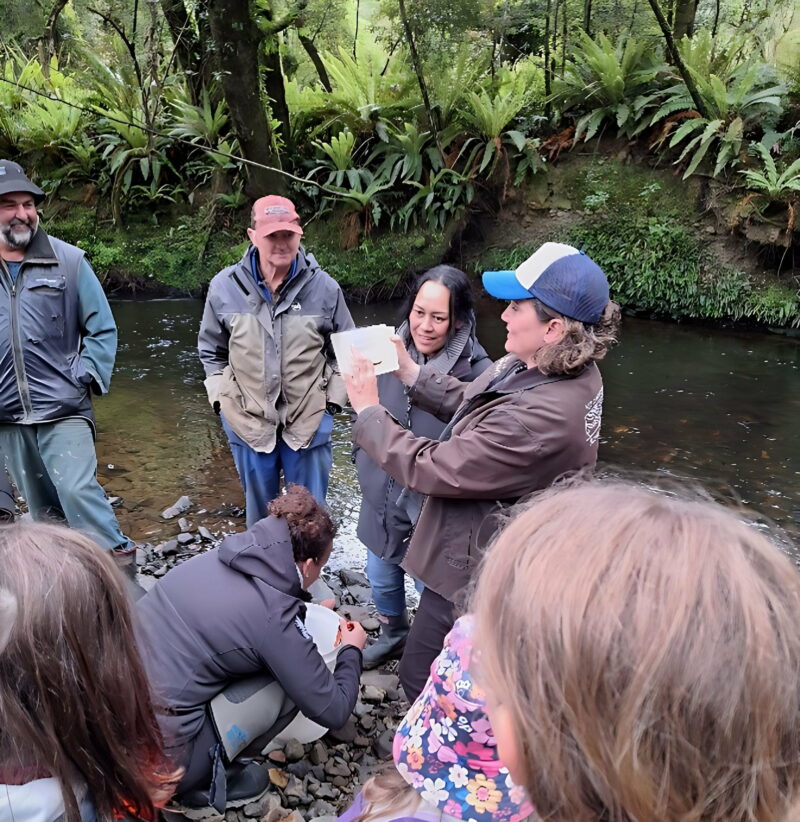The presence of the ancient and unusual kanakana (pouched lamprey) in a catchment near the settlement of Aparima Riverton in Southland is uniting a community that is examining land practices to enhance waterway (drain) management on farms. Kanakana are a migratory jawless fish and a valued mahika kai species once prolific throughout Murihiku Southland.
BioHeritage’s Freshwater for our Taonga team includes researchers from Ōraka-Aparima Rūnaka, namely co-Lead Jane Kitson and Taiao Kaitiaki Kas Peterson, as well as members of the farming community within the Pourakino catchment, supported by Dave Diprose. Together with researchers from the University of Canterbury’s Freshwater Ecology Research Group (co-leads Helen Warburton and Angus McIntosh) and Programme Manager Kerri-Anne Edge, the team is at the nexus of a collaboration that values and prioritises Te Ao Māori approaches to restoration, listening to and learning from one another, as well as fostering inter-generational relationships. They are now on a pathway to co-designing research for better farm waterway management to help preserve kanakana in the Pourakino River catchment.
“BioHeritage’s investment in this project has been focused on knowledge sharing and supporting the growth of relationships, building our collective skill base, especially with rangatahi and early career folk, and the early stages of co-design”, says co-lead Helen Warburton. “In the last six months, we were fortunate to receive one final boost of funding to develop an investment pathway with strategic advice from Andrea Byrom and Nathaniel Calhoun. Although Andrea and Nathaniel look at the challenge of funding future research from different perspectives, both hold the level of expertise in impact investment that we are keen to draw on.”
With future funding, the research will, among several things, examine what is required to shift modern on-farm practices for drain management towards approaches that improve outcomes for kanakana throughout the Pourakino, Omutu Stream and Ōraka Colac Bay catchments. Key elements will be those that support the diversity of perspectives and approaches available to the team: the aspirations of mana whenua to reconnect with and restore the mauri of these waterways, a need for economically and environmentally sustainable farming, and advancing knowledge of biotic interactions in the freshwater restoration process for species recovery.
The local collaboration has the potential to be upscaled, as well as being a model for other catchments on joint action for waterway management and restoration.
The initiative, which has its roots within the community and way before the second tranche of BioHeritage, has sparked more interest in the primitive, jawless fish that look like eels but are more closely related to sharks and rays. The presence of kanakana has also generated discussion about community aspirations for the area around the river and estuary and whether different ways of managing water drainage could help restore more kanakana in the productive rural catchment.
BioHeritage’s Freshwater for our Taonga researchers’ involvement in the process has helped facilitate the sharing of knowledge and the expression of hopes that waterway restoration will allow mahika kai – the traditional harvest of kanakana, considered a prized delicacy. Even though kanakana are less active during the day and often hide until dark, the migratory creature has served to highlight to the wider community its role as an indicator of land and waterway hauora and health and the value of kanakana as a food resource if the ecosystem is sustainably managed. Future research will influence on-farm management decisions, with the learnings about kanakana and trial restoration that considers biological, ecological and social connections relevant beyond the catchment and Murihiku Southland, as migratory freshwater lamprey are found in other regions around the world, including Australia and North and South America.
The Freshwater for our Taonga team has been instrumental in connecting people, projects, and communities actively working to restore and protect healthy populations of kanakana across Murihiku Southland and New Zealand-wide as part of ‘Operation Kanakana’.
There’s more about kanakana, also known as piharau, and the work underway on kanakana across Murihiku Southland on Facebook
